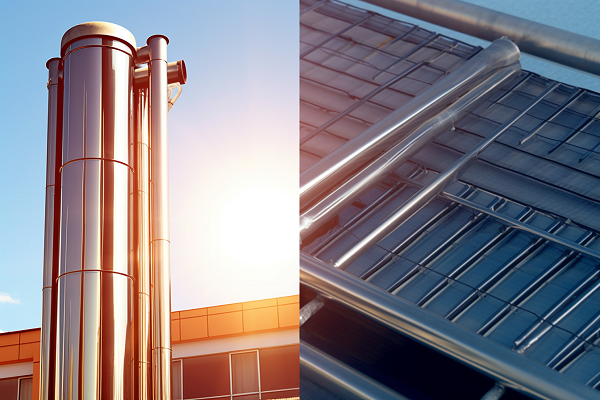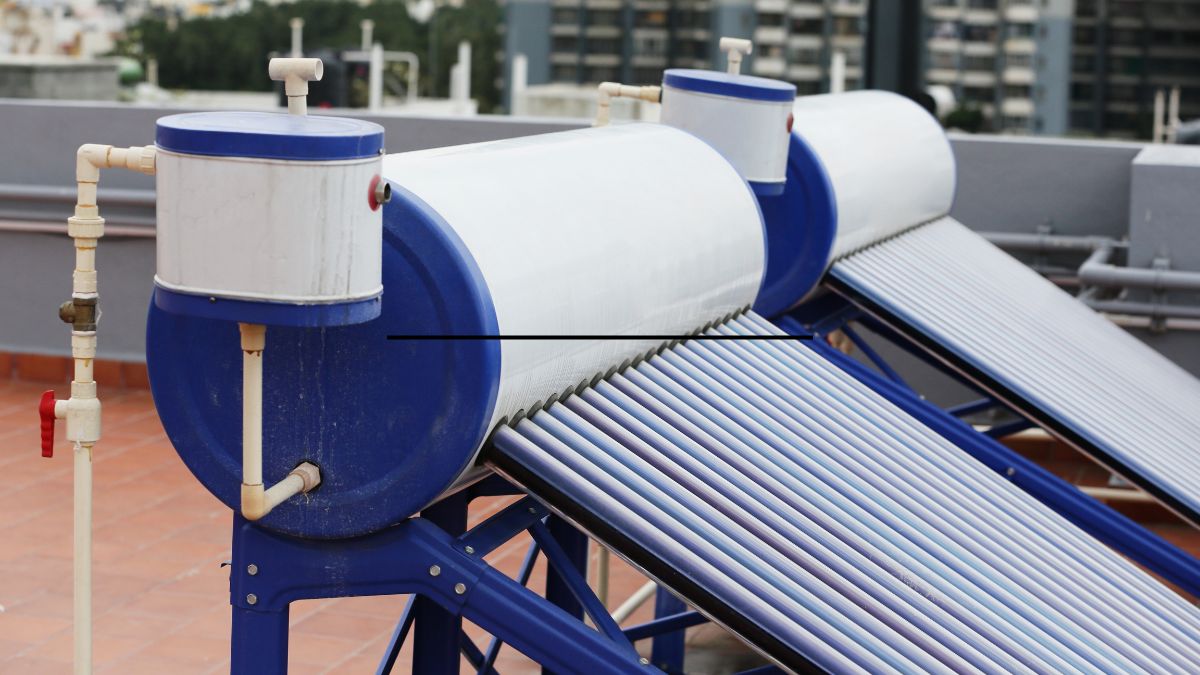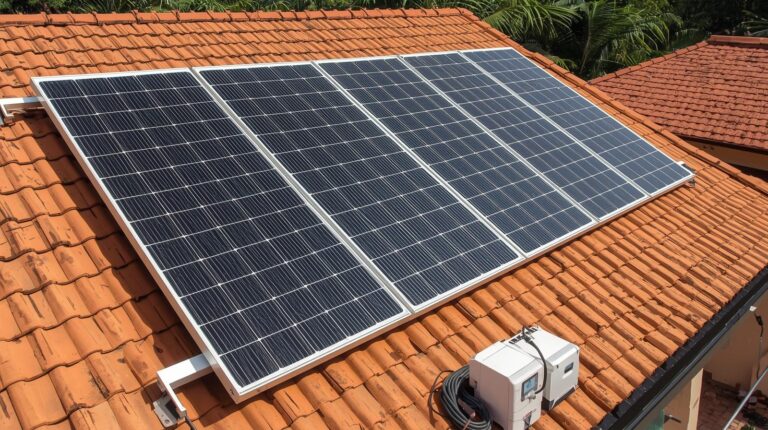A commercial solar water heater has become increasingly popular in recent years as businesses and industries seek ways to reduce their energy consumption and carbon footprint. These systems offer a cost-effective and environmentally friendly solution for heating water, which is essential for various applications, such as cooking, cleaning, and manufacturing processes.
By harnessing the power of the sun, solar hot water systems can save businesses significant amounts of money on their energy bills and provide a return on investment within a short period. There are different types of commercial solar water heater systems available, each with its unique features and benefits.
Understanding the differences between these systems is crucial in determining the most suitable one for a particular business or industry. This article aims to explore the various types of solar hot water systems and their benefits, as well as the expertise and services of top solar water heating contractors.
By providing this information, we hope to help businesses make informed decisions about investing in a solar hot water system and contribute to the global efforts to reduce carbon emissions and build a more sustainable future.
Key Takeaways
- Solar water heaters are a cost-effective way to generate hot water for commercial buildings and can save businesses 40-80% on heating water costs.
- There are two types of solar water heaters: active and passive, with passive systems relying on convection and being less expensive to install than active systems.
- Solar hot water systems have a long lifespan of 30 years or more, produce no greenhouse gas emissions, and can help businesses control energy costs.
- Proper installation should be done by a qualified solar thermal systems contractor.
- It’s important to estimate cost and energy efficiency, evaluate the site’s solar resource, determine the correct system size, and investigate local codes and regulations before purchasing and installing a solar water heating system.
Types of Commercial Solar Water Heater Systems
When it comes to solar water heaters, there are two main types of systems: active and passive. Active systems use a pump to circulate water and can reduce water heating costs up to 80%. On the other hand, passive systems rely on convection and are less expensive to install than active systems. Passive systems can reduce water heating costs up to 75%, making them a cost-effective investment for businesses looking to save money and reduce their carbon footprint.
Direct circulation and indirect circulation are two types of active systems. Direct circulation systems use pumps to circulate water through the collectors and into the home, while indirect circulation systems use a heat exchanger to transfer heat from the collector to the water.
Passive systems are typically less expensive but less efficient than active systems. Integral collector-storage and thermosyphon are two basic types of passive systems. The former uses a tank located above the solar collector while the latter uses a tank located below the collector.
When deciding between active and passive solar water heating systems, it’s important to consider the climate suitability and efficiency comparison. Passive systems are typically more suitable for warmer climates with plenty of sunshine. They also require less maintenance than active systems. However, active systems are more efficient and can provide hot water even on cloudy days.
In the next section, we will discuss the advantages and disadvantages of each system in more detail.
Active vs. Passive Solar Water Heating Systems
The efficiency and cost-effectiveness of solar water heating systems vary depending on the type, with active systems utilizing pumps and controls for increased efficiency, while passive systems rely on natural convection and are less expensive to install. When deciding whether to choose an active or passive system for your commercial solar water heating needs, it is important to consider factors such as cost, efficiency, and maintenance.
Cost Comparison: Active vs. Passive Solar Water Heating Systems
Active systems are typically more expensive to install due to the additional components such as pumps and controls. However, they are generally more efficient, able to reduce water heating costs by up to 80%. Passive systems, on the other hand, rely on natural convection and do not require additional components, making them less expensive to install but typically less efficient, reducing water heating costs by up to 75%.
Choosing the Right Solar Collector
The type of solar collector used in a commercial solar water heating system is also an important factor to consider. Flat-plate collectors are the most common and are suitable for most applications. Evacuated-tube solar collectors are more efficient in colder climates, while integral collector-storage systems are a type of passive system that combines a storage tank and collector in one unit, making them ideal for smaller installations. It is important to work with a qualified solar thermal systems contractor to determine the best collector for your specific needs.
Understanding Integral Collector Storage Systems
Integral collector storage (ICS) systems are a type of passive system that combines a storage tank and solar collector in one unit. They are typically less expensive to install than active systems and require minimal maintenance. ICS systems are ideal for smaller commercial installations where space is limited. They rely on natural convection to circulate water, making them less efficient than active systems but still able to reduce water heating costs by up to 75%.
Integral Collector Storage
Integral Collector Storage (ICS) systems are a popular option for businesses and homeowners looking to save on energy costs while reducing their environmental impact. These systems store solar energy in a large tank for later use, making them an efficient and cost-effective option.
Compared to other solar water heating systems, ICS requires less maintenance and is typically less expensive to install, making it an ideal choice for smaller-scale installations. The efficiency of integral collectors is one of their key benefits. These collectors are designed to absorb and retain solar energy, which is then transferred to the storage tank.
This process allows for a consistent supply of hot water, even on cloudy days or during periods of increased demand. For hotels and other businesses that rely heavily on hot water, ICS systems can significantly reduce energy costs and improve overall efficiency. In addition to their cost effectiveness, ICS systems also offer tax credits and incentives for businesses that switch to solar.
These benefits, combined with the environmental impact of reducing greenhouse gas emissions, make ICS an attractive option for businesses looking to make a positive impact on the environment while also saving money. In the next section, we will explore the benefits of thermosiphon systems and how they compare to ICS.
Thermosiphon
Thermosiphon systems, a type of passive solar water heating system, utilize the natural convection process to circulate water, making them a simple and reliable option for homeowners and businesses looking to reduce energy costs and lower their carbon footprint.
Unlike active solar water heating systems, thermosiphon systems do not require pumps or controls, which can make them a more cost-effective option. Additionally, thermosiphon systems can be easier to install and require less maintenance over time.
However, thermosiphon systems do have some limitations. They typically require a higher initial investment than traditional water heaters, and their efficiency may be affected by the weather and climate conditions. Additionally, thermosiphon systems may not be suitable for larger commercial applications, where active systems may be a more efficient option.
Overall, thermosiphon systems can offer many advantages for homeowners and businesses looking to reduce their energy costs and environmental impact. Proper installation and maintenance by a qualified solar thermal systems contractor can help ensure the system operates efficiently and provides reliable hot water.
The Different Types of Solar Collectors

Solar collectors are an essential component of solar water heating systems, with evacuated-tube solar collectors being the most efficient, converting up to 90% of sunlight into usable heat. These collectors consist of a series of glass tubes containing a vacuum that prevents heat loss, and a copper or aluminum absorber that absorbs sunlight and transfers the heat to the water. The tubes are connected to a manifold that connects to the storage tank and the pump, which circulates the water through the collectors.
When considering solar water heating systems, it is important to compare the efficiency of different types of collectors, as well as their size and installation process. Evacuated-tube solar collectors are more efficient than flat-plate collectors, but they are also more expensive and require more maintenance. Additionally, the size of the collector should be determined based on the amount of hot water needed and the available solar resource at the installation site. The installation process for solar collectors should be done by a qualified solar thermal systems contractor to ensure proper function and safety.
Cost analysis is another important factor to consider when choosing a solar water heating system. While evacuated-tube solar collectors may have a higher upfront cost, their efficiency can lead to long-term cost savings on energy bills. Maintenance requirements should also be taken into account, as simple systems may only require maintenance every 3-5 years.
Flat-Plate Collector
The flat-plate collector is a fundamental component in solar heating systems, designed to collect and transfer solar energy into usable heat. It consists of a shallow, rectangular box with a glass sheet on top, a dark absorber plate in the middle, and insulation at the bottom.
The absorber plate is typically made of metal, such as copper or aluminum, and is coated with a selective coating that maximizes absorption of solar radiation. When sunlight hits the absorber plate, it heats up and transfers the energy to the fluid running through the collector. The fluid is then pumped to a heat exchanger, where the heat is transferred to the water in the storage tank.
One of the advantages of flat-plate collectors is their efficiency in converting sunlight into heat. They can achieve thermal efficiencies of up to 80%, depending on the design and operating conditions. They are also cost-effective, with a relatively low upfront cost compared to other types of solar collectors.
Flat-plate collectors are durable and can last for 20-30 years, with minimal maintenance required. They also offer customization options, such as the size and orientation of the collector, to suit different applications and site conditions.
While flat-plate collectors are widely used in solar heating systems, they have some limitations. They are less efficient in cold and cloudy weather, and their performance can be affected by shading and dirt accumulation.
To overcome these limitations, evacuated-tube solar collectors are an alternative option that can provide higher thermal efficiencies and better performance in low-light conditions.
Evacuated-Tube Solar Collectors
Evacuated-tube solar collectors are a type of solar collector that is commonly used in solar heating systems due to their high thermal efficiency and ability to perform well in low-light conditions. These collectors consist of a series of glass tubes, each with a vacuum between the inner and outer layers. The vacuum helps to reduce heat loss, allowing the tubes to absorb more heat from the sun. The tubes are typically made of borosilicate glass, which is highly durable and can withstand extreme temperatures.
Efficiency comparison is an important consideration when choosing between different types of solar collectors. Compared to flat-plate collectors, evacuated-tube solar collectors have a higher thermal efficiency, which means that they are better at converting sunlight into usable heat. However, they are also typically more expensive to install and require more maintenance. It is important to conduct a cost analysis and durability assessment before making a decision on which type of collector to use. Additionally, climate suitability is also a factor to consider, as evacuated-tube solar collectors may not be as effective in areas with high wind or hail.
During the installation process, it is important to work with a qualified solar thermal systems contractor to ensure that the system is installed properly and safely. The installation process typically involves mounting the collectors on a roof or other structure, connecting them to a storage tank, and installing a backup system for cloudy days and times of increased demand.
In the next section, we will discuss the importance of backup systems in solar water heating systems and the different options available.
Backup Systems for a Commercial Solar Water Heater
One crucial aspect of a solar water heating system is the backup system, which ensures that hot water is available even during times of low solar radiation. Backup systems are necessary to provide hot water during extended periods of cloudy weather, and to meet high demand for hot water.
There are several backup options available to ensure continuous hot water supply, including electric or gas water heaters, and heat pump water heaters. Pros and cons exist for each backup option, and a cost analysis and efficiency comparison should be conducted to determine the best backup system for each individual situation.
- Electric water heaters are the most commonly used backup option, as they are affordable and easy to install. However, they can be costly to operate in areas with high electricity rates, and may not be the most energy-efficient option.
- Gas water heaters are another popular backup option, as they are cost-effective and efficient, but they require a gas line and proper venting.
- Heat pump water heaters are the most energy-efficient option, but they can be expensive to install and require a large space for installation.
Maintenance requirements for backup systems vary, but it is important to ensure that they are regularly maintained to ensure their reliability and efficiency. Proper installation and sizing of backup systems is also crucial for their performance.
In the next section, we will explore the installation and maintenance requirements for solar water heating systems, including the importance of working with qualified contractors to ensure proper installation and maintenance.
Installation and Maintenance
Proper installation and maintenance of solar water heating systems are essential to ensure their optimal performance and longevity. Installation tips for solar water heaters include identifying the best location for the solar collector, ensuring proper insulation of the storage tank, and selecting the appropriate size of the solar water heating system. It is recommended that solar water heating systems be installed by a qualified solar thermal systems contractor to ensure that the system operates efficiently and safely.
Maintenance checklist for solar water heating systems should include regular inspection of the solar collector, the storage tank, and the pumps and controls. Common issues that may arise include leaks, sediment buildup, and damage to the collector or storage tank. A troubleshooting guide should be in place to address any issues that may arise and to provide appropriate solutions. Best practices for maintaining solar water heating systems include ensuring that the system is properly drained and cleaned on a regular basis and replacing any damaged or worn out components.
Incorporating energy-saving strategies can help lower water heating bills and further increase the efficiency of solar water heating systems. These strategies include reducing hot water usage, insulating hot water pipes, and using low-flow showerheads and faucets. By adopting these energy-saving strategies, businesses can further reduce their energy costs and environmental impact.
By implementing these strategies, businesses can not only save money but also reduce their carbon footprint.
Energy-Saving Strategies for Commercial Solar Water Heater System
Implementing energy-saving strategies can significantly reduce the energy costs and environmental impact of businesses using solar hot water systems. Reducing consumption and maximizing efficiency are key components of such strategies.
One way to reduce consumption is by using low-flow faucets and showerheads, which can reduce hot water usage by up to 50%. Additionally, installing timers or sensors on lighting and HVAC systems can help businesses conserve energy by reducing usage during off-hours.
Maximizing efficiency is another important component of energy-saving strategies. It involves ensuring that solar hot water systems are properly sized and maintained. A qualified solar thermal systems contractor should perform regular maintenance to ensure that systems are operating at optimal performance.
Additionally, businesses can maximize efficiency by ensuring that their storage tanks are well-insulated. This can help reduce standby losses and ensure that hot water is readily available when needed.
Cost savings and environmental benefits are two of the most significant advantages of using solar hot water systems. Energy-saving strategies can help businesses realize these benefits by reducing their energy consumption and maximizing the efficiency of their systems.
By investing in renewable energy sources such as solar hot water systems, businesses can help reduce their carbon footprint and demonstrate their commitment to sustainability.
Commercial Solar Water Heater FAQs
What is the typical lifespan of a commercial solar water heater?
The typical lifespan of a solar water heater depends on various factors, such as maintenance and usage. With proper maintenance, a commercial solar water heater can last more than 20 years, providing advantages such as durability, efficiency, and cost effectiveness.
How can solar hot water systems benefit businesses in the hotel industry?
Hotels can benefit from solar hot water systems due to cost savings, environmental impact, and reliability. Proper system design and installation, as well as regular maintenance and upkeep, ensure maximum efficiency and longevity.
Are there any safety concerns associated with a commercial solar water heater?
Solar panel durability, maintenance requirements, efficiency ratings, installation costs, and climate considerations are important factors to consider when evaluating safety concerns associated with solar water heaters. Proper installation and regular maintenance can help mitigate potential risks.
Can solar hot water systems be used for process heating in manufacturing facilities?
Solar hot water systems can be used for process heating applications in manufacturing facilities, offering high solar thermal efficiency with low maintenance requirements. An ROI analysis can determine cost-effectiveness, while environmental impact is reduced by using clean energy.
What kind of incentives are available for businesses that invest in commercial solar water heating systems?
Businesses investing in solar hot water systems can benefit from tax credits and incentives, cost savings on energy bills, and a reduced environmental impact. Proper installation and maintenance are required for optimal results.
Conclusion
In conclusion, commercial solar water heater is a cost-effective and sustainable solution for generating hot water in various applications. The different types of systems, such as active and passive, integral collector storage, and thermosiphon, provide flexibility in meeting individual business needs. The use of solar collectors, specifically evacuated-tube solar collectors, maximizes energy efficiency and reduces operating costs. Backup systems ensure uninterrupted hot water supply, while proper installation and maintenance by experienced contractors like Solar Source, Northern Lights Solar Solutions, and AET, guarantee long-term performance.
In light of the current emphasis on environmental sustainability, investing in a commercial solar water heater not only reduces carbon emissions but also demonstrates a commitment to corporate social responsibility. As businesses strive to reduce operating costs, a solar hot water system offers a viable opportunity to save up to 80% on heating water. By leveraging the expertise of experienced contractors, businesses can ensure optimal performance and maximize their return on investment within a short period.
Ultimately, the decision to invest in a solar hot water system is not only a sound financial decision but also a responsible choice for the environment. As such, businesses should consider the benefits of a commercial solar water heater and take the necessary steps to implement them in their operations.
To emphasize, can businesses afford not to invest in a commercial solar water heater with its proven cost-saving potential and environmental benefits?




